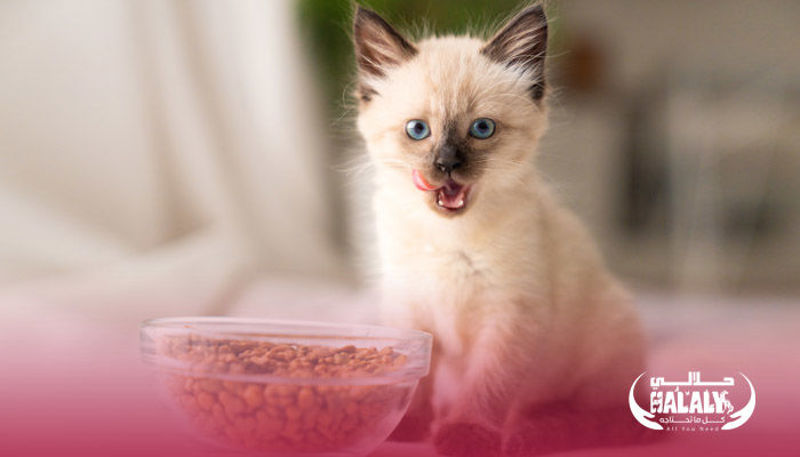Usually, first-time mothers get fully prepared to welcome their new bundle of joy way before birth.
She buys suitable clothes for the baby, prepares the crib, and provides all the needed amenities for her newborn..
And above all that; The mother learns all she can about raising and caring for the child, so she studies the proper ways of feeding the baby and asks other mothers about the appropriate food for each age stage; in order for the baby to grow healthy and strong.
The process of searching for nutrition requirements and what to feed children is relatively simple. But what about feeding cats?!
Many cat owners wonder what the best types of food for both kittens and adult cats are. Wonder no more, we will inform you all about cat food in this article.
Cat Nutrition
To maintain cats’ health, protect them from potential diseases, especially aging diseases, and increase their lifespan, you must pay attention to the type, quality, and quantity of food you give your cat.
Cat Food Types
There are various kinds of cat food in the market, and cat owners choose which type of food depending on many factors such as the cats’ age, health condition, and preferences. and of course, the finances of the owner play a big role in deciding what kind of food and what brand to get Here are the types of cat food available on the market:
Dry food
Dry food has several advantages for both cats and their owners. It is easy to prepare, nutritionally complete, and balanced covers all age stages, and helps in preventing dental problems. Dry food is in fact a popular choice of cat owners because, besides the fact that it is available in many flavors and shapes to suit all ages and health conditions of cats, it is not messy at all, and its prices vary so it is actually in every cat owner's financial means.
Semi-Moist Cat Food
Among the numerous variants, Semi-moist cat food is one of the most popular types of cat food. It usually consists of meaty chunks in gravy or jelly, in addition to some other additives, such as sugar, salt, and food preservatives.
With a moisture value of around 60%, It is reasonably priced, which makes it affordable for most cat owners.
Usually sold in handy pouches, semi-moist products are easy-to-use, portioned as separate meals, and, like dry food, it is also nutritionally complete and balanced. Many manufacturers offer age-adjusted semi-moist pouches, and it is highly palatable and comes in various flavors that are particularly attractive to cats.
Canned Food
It is by far the optimum favorite for cat owners. It has the convenience of semi-moist products but brings real nutritional value to your feline’s diet. It is also the most expensive type of cat food. The tinned can of cat food contains around 70% moisture which provides a good proportion of the water required for the cat's health, protecting it from some health issues such as kidney stones and kidney failure. Also, the manufacturing process allows the makers not to use gelling agents, so the canned food closely mimics the cat's natural diet. In addition to containing many nutrients important for health, canned food provides a good proportion of the water required for the health of the cat, protecting it from some health problems such as the formation of stones and kidney failure.
Dangerous Foods for Cats
All cat owners must know that, due to the sensitivity of cats' stomachs, there are some foods that are quite harmful for cats. These foods may cause an allergic reaction or serious long-term complications. If you are a cat owner, please do not feed your cat the following:
Milk
Unexpectedly, drinking lactose-containing milk is unpleasant for cats after adulthood. It usually causes diarrhea because an adult cat's digestive system is unable to digest lactose.
Desserts (Sugar)
Vomiting and lethargy are among the most serious complications of cats eating sweets. Sugar is one of the substances that has a harmful effect on cats as it may cause high blood sugar and liver failure.
Onions and garlic
Eating food that contains onions or garlic may cause severe anemia in cats because these foods contain sulfur compounds that cause the breakdown of their red blood cells.
Raw meat/eggs
Among the causes of salmonella infection in cats is eating immature eggs; So, always make sure to thoroughly cook meat in general and eggs in particular.
Grapes
To protect your cats from kidney failure, completely avoid serving them grapes in any form!
Alcoholic beverages
Although it is uncommon to offer a cat an alcoholic beverage; However, we recommend that cats be kept away completely from places where alcoholic beverages are consumed in general, so that they do not accidentally drink and get alcohol poisoning.
Caffeine
Caffeine has the same effect on cats that it has on humans. It affects both the urinary and nervous systems in cats. It stimulates the nervous system and increases both diuresis and heart rates.
Chocolate is one of the most harmful for cats, not only because it contains a large amount of caffeine, but also because it contains theobromine, which may cause sudden death in cats.
Learn about the best food for kittens
In order for the kitten to grow up healthy, cat owners must make sure to provide it with all the important nutrients in meals, so that its immune system develops properly and plays its role in resisting bacteria and viruses that represent a great threat to cats, especially kittens.
One-month-old kittens’ nutrition
It is normal for kittens to depend mainly on their mother's milk for the first two months to get all the nutrition they need. However, you may find yourself in a situation where you have to know how to feed a newborn kitten.
In the event that the kitten is unable to obtain its mother's milk, here are the best ways to feed kittens at the age of one month or younger, to avoid weakening their immune systems and prevent malnutrition at that age.
You can replace the mother's milk with kittens formula milk, as it is preferable to give them milk every two to three hours a day, in addition to keeping them warm all the time during the first three weeks.
You can offer the kitten some simple wet food at 4 weeks of age, by gradually introducing small amounts of food into the cat's mouth yourself.
Among the foods suitable for cats at this stage are boiled potatoes, cheese, boiled rice, and hard-boiled eggs.
Feeding kittens older than a month
The weaning phase may begin four weeks after birth and may extend to eight weeks. Kittens older than 4 weeks need a larger amount of calories, as kittens grow rapidly at that stage.
You should refrain from providing formula milk at this stage; This is due to the kitten's inability to digest lactose at that age and the increased possibility of developing a sensitivity to it.
Although there is a lot of information available on the healthiest foods and the best feeding methods for cats, science is always evolving to keep up with the nutritional requirements for good health. So, if you notice any change in your cat's health, do not hesitate to consult your vet, or visit the veterinary clinic as soon as possible.























































